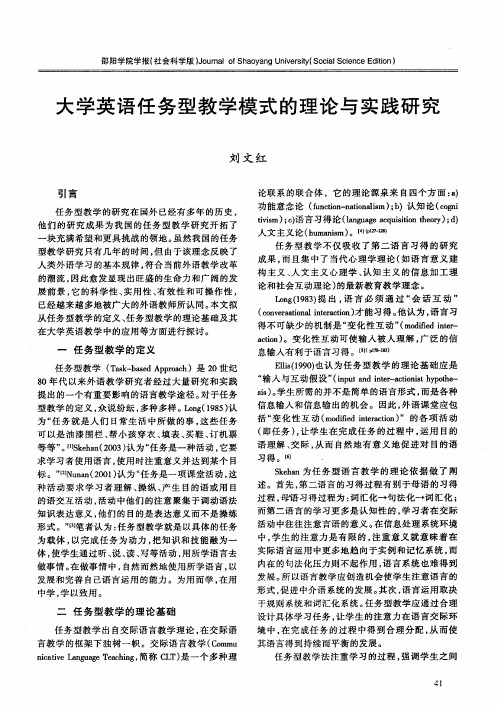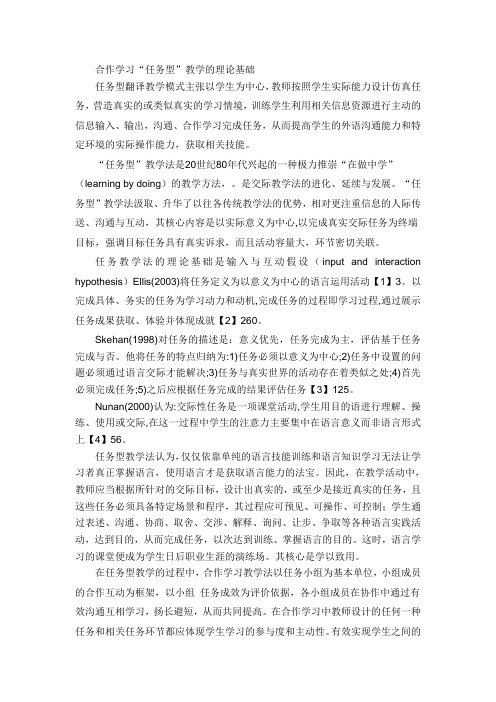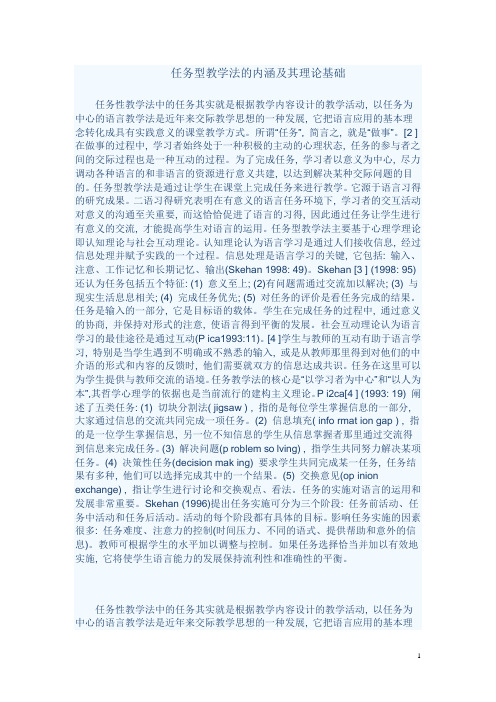任务型理论
大学英语任务型教学模式的理论与实践研究

为 载体 , 以完 成 任务 为 动力 , 把知 识 和 技能 融 为一 体, 使学 生通 过 听 、 、 、 说 读 写等 活动 , 所学语 言去 用
做事 情 。 做事 情 中 , 在 自然而然 地使 用所 学语言 , 以 发展 和完 善 自己语 言运 用 的能力 。为 用而 学 , 型教 学 ( ak b e p r c )是 2 T s— a dA po h s a 0世 纪 8 0年 代 以来 外语 教 学研 究 者 经过 大量 研究 和 实 践 提 出的一个 有重要 影 响 的语 言教 学途径 。 于任务 对 型 教学 的定 义 , 说纷 纭 , 众 多种 多样 。Ln ( 9 5 认 og 18 ) 为“ 任务 就 是 人 们 E常 生 活 中所做 的事 , 些 任务 l 这
可 以是油 漆 围栏 、 帮小 孩 穿衣 、 表 、 鞋 、 机票 填 买 订 等 等 ” [ khn 20 ) 为 “ 。1 ea ( 0 3 认 l S 任务是 一种 活动 , 它要 求 学 习者 使用 语言 , 用 时注 重意义 并 达到某 个 目 使 标 。” lu a (0 1 认 为 “ 务是 一项课 堂活动 , [ nn20 ) 2 N 任 这
人 文 主 义 论 ( u n m) (7嚣 hmai 。【 p - ) s J1 2
引 言
任 务 型教 学 的研究 在 国外 已经有 多 年 的历史 ,
他们 的研 究成 果 为 我 国 的任 务 型教 学 研究 开 拓 了
一
块 充满希 望 和更具 挑 战的领 地 。 虽然我 国的任 务
从 任务 型教 学 的定 义 、 任务 型 教学 的理 论基 础及 其 在 大学 英语 教学 中的应用等 方 面进行 探讨 。
合作学习任务型教学:理论基础

合作学习“任务型”教学的理论基础任务型翻译教学模式主张以学生为中心,教师按照学生实际能力设计仿真任务,营造真实的或类似真实的学习情境,训练学生利用相关信息资源进行主动的信息输入、输出,沟通、合作学习完成任务,从而提高学生的外语沟通能力和特定环境的实际操作能力,获取相关技能。
“任务型”教学法是20世纪80年代兴起的一种极力推崇“在做中学”(learning by doing)的教学方法,。
是交际教学法的进化、延续与发展。
“任务型”教学法汲取、升华了以往各传统教学法的优势,相对更注重信息的人际传送、沟通与互动,其核心内容是以实际意义为中心,以完成真实交际任务为终端目标,强调目标任务具有真实诉求,而且活动容量大,环节密切关联。
任务教学法的理论基础是输入与互动假设(input and interaction hypothesis)Ellis(2003)将任务定义为以意义为中心的语言运用活动【1】3。
以完成具体、务实的任务为学习动力和动机,完成任务的过程即学习过程,通过展示任务成果获取、体验并体现成就【2】260。
Skehan(1998)对任务的描述是:意义优先,任务完成为主,评估基于任务完成与否。
他将任务的特点归纳为:1)任务必须以意义为中心;2)任务中设置的问题必须通过语言交际才能解决;3)任务与真实世界的活动存在着类似之处;4)首先必须完成任务;5)之后应根据任务完成的结果评估任务【3】125。
Nunan(2000)认为:交际性任务是一项课堂活动,学生用目的语进行理解、操练、使用或交际,在这一过程中学生的注意力主要集中在语言意义而非语言形式上【4】56。
任务型教学法认为,仅仅依靠单纯的语言技能训练和语言知识学习无法让学习者真正掌握语言,使用语言才是获取语言能力的法宝。
因此,在教学活动中,教师应当根据所针对的交际目标,设计出真实的,或至少是接近真实的任务,且这些任务必须具备特定场景和程序,其过程应可预见、可操作、可控制;学生通过表述、沟通、协商、取舍、交涉、解释、询问、让步、争取等各种语言实践活动,达到目的,从而完成任务,以次达到训练、掌握语言的目的。
任务型教学模式的理论基础及课堂实

践《英语课程标准》明确提出:“将学生的发展作为英语课程的出发点和归宿。
”制定了“知识与技能,过程与方法,情感态度与价值观三位一体”的课程功能,旨在帮助学生掌握学习英语的方法,培养他们终身学习的能力,强调“课程从学生的学习兴趣,生活经验和认识水平出发,倡导体验,时间参与,合作与交流的方式和任务性的教育途径。
发展学生的综合语言能力,使语言学习的过程成为学生形成积极的情感态度,主动思维和大胆实践,提高跨文化意识和形成自主学习能力的过程。
任务型教学(Task-based Teaching)以具体的任务过程为学习过程,以展示任务成果的过程的方式来体现教学成就。
它以任务为中心,已完成任务为目的,让学生通过实际活动来学习语言,它使语言学习和语言运用达到高度统一。
它具有以下特点:(1)以意义为中心,而不是以操练某种意义不大甚至无意以的语言形式为目的;(2)任务的焦点是解决某一交际问题,这一问题必须与现实世界有某种关系。
学生通过“执行”并完成任务,学习词汇和短语。
更重要的是学会处理人际关系和解决实际生活中遇到的问题和困难,这无疑是外语教学的改进。
人民教育出版社JEFC的每个单元成功地将话题,功能,结构任务相符合,为教师及学生提供了大量的任务,使任务型教学模式的实施成为可能,这种教学内容和教学方法相互配合,将有利于英语课堂教学的优化,结合本人的教学实践,笔者认为任务性教学也有以下几点:(1)任务型教学模式有利于充分发挥学生学习的积极主动性,培养他们的自主学习能力在课堂教学中,教师围绕课文的主题并根据学生的实际情况惊醒任务的设计,学生会对该任务表现出关心和兴趣,他们就容易产生实用新语言的欲望。
所以,在任务型的课堂上,学生始终处于一种积极的主动的学习心理状态,任务的参与者之间的交流是一种互相支持的过程,为了完成任务,学生尽量调到各种语言和非语言资源,进行任务分析,进而完成任务,以达到解决问题而进行交流的目的。
例如:JEFCB1A Lesson 30 ,设计的任务(Task)是1) Ask somequestions about your friend ?2)Make your friend card..学生为把自己朋友的信息极可能多的表达出来,积极主动的查阅资料、翻阅报刊、查找词典、上网查询,甚至请教家长和老师,取得了良好效果。
任务型教学法的内涵及其理论基础

任务型教学法的内涵及其理论基础任务性教学法中的任务其实就是根据教学内容设计的教学活动, 以任务为中心的语言教学法是近年来交际教学思想的一种发展, 它把语言应用的基本理念转化成具有实践意义的课堂教学方式。
所谓“任务”, 简言之, 就是“做事”。
[2 ]在做事的过程中, 学习者始终处于一种积极的主动的心理状态, 任务的参与者之间的交际过程也是一种互动的过程。
为了完成任务, 学习者以意义为中心, 尽力调动各种语言的和非语言的资源进行意义共建, 以达到解决某种交际问题的目的。
任务型教学法是通过让学生在课堂上完成任务来进行教学。
它源于语言习得的研究成果。
二语习得研究表明在有意义的语言任务环境下, 学习者的交互活动对意义的沟通至关重要, 而这恰恰促进了语言的习得, 因此通过任务让学生进行有意义的交流, 才能提高学生对语言的运用。
任务型教学法主要基于心理学理论即认知理论与社会互动理论。
认知理论认为语言学习是通过人们接收信息, 经过信息处理并赋予实践的一个过程。
信息处理是语言学习的关键, 它包括: 输入、注意、工作记忆和长期记忆、输出(Skehan 1998: 49)。
Skehan [3 ] (1998: 95) 还认为任务包括五个特征: (1) 意义至上; (2)有问题需通过交流加以解决; (3) 与现实生活息息相关; (4) 完成任务优先; (5) 对任务的评价是看任务完成的结果。
任务是输入的一部分, 它是目标语的载体。
学生在完成任务的过程中, 通过意义的协商, 并保持对形式的注意, 使语言得到平衡的发展。
社会互动理论认为语言学习的最佳途径是通过互动(P ica1993:11)。
[4 ]学生与教师的互动有助于语言学习, 特别是当学生遇到不明确或不熟悉的输入, 或是从教师那里得到对他们的中介语的形式和内容的反馈时, 他们需要就双方的信息达成共识。
任务在这里可以为学生提供与教师交流的语境。
任务教学法的核心是“以学习者为中心”和“以人为本”,其哲学心理学的依据也是当前流行的建构主义理论。
任务型英语教学的理论依据

任务型英语教学的理论依据作者:张志峰来源:《学理论·上》2011年第03期摘要:任务型教学理论是20世纪80年代外语教学法研究者和第二语言习得研究者在大量研究和实践的基础上提出来的有重要影响的学习理论,其理论基础是“任务型学习”(Task—basedlearning)理论,它把语言应用的基本理念转化为具有实践意义的课堂教学模式。
任务型教学强调了学生语言运用能力的培养,充分体现了以教师为主导、以学生为主体的素质教育理念,在英语课堂教学中越来越显示出其优越性。
为了更好理解并在教学活动中准确运用这一先进的教学方法,阐述了支撑这一教学方法的哲学心理学和语言学方面的理论依据。
关键词:素质教育;任务型教学理论;建构主义理论中图分类号:G64文献标志码:A 文章编号:1002-2589(2011)07-0193-02在英语教学过程中要以学生为中心,教师起指导作用。
学生在完成任务活动时,教师指导学生发现问题、思考问题和解决问题,从而获取知识。
这样提高了学生学习的积极性和主动性。
如果任务内容过分单调、死板,学生不能充分发挥自己的思维和想象,这样造成课堂气氛不活跃,不能调动学生积极参与,进而影响教学任务活动的有效完成。
任务型语言教学是一种涉及到学生理解,运用所学语言进行交流的课堂活动。
在这种活动时学生的注意力主要集中在语言的意义上,而不是语言的形式上,这与语言练习教学有着本质的区别。
任务型教学所谋求的效果不是一种机械的语言训练,而是侧重在执行任务中学生自我完成任务的能力和策略的培养。
它重视学生在完成任务过程中的参与和在交流活动中所获得的经验。
根据语言习得的规律,任务型语言教学使语言知识加交际的机会比仅仅讲语法更能提高学生使用语言的流利程度与语法的准确度,学生的参与与语言熟练程度的提高关系极大。
任务型教学是基本上以“交际”为导向的课堂教学,但同时也有明确的语法讲解,这要比只注重语法教学或回避语法讲解的沉浸式教学都更好。
任务型教学理论

任务型教学理论《英语课程标准》(实验稿)提出,制定该标准的理念是:面向全体学生,注重素质教育;整体设计目标、体现灵活开放;突出学生主体,尊重个体差异;采用活动途径,倡导体验参与;注重过程评价,促进学生发展;开发课程,拓展学用渠道。
其中最引人注目的是采用活动途径,倡导体验参与,即倡导任务型的教学途径,让学生在教师的指导下,通过感知、体验、实践、参与、合作等方式,实现任务中制定的目标,从而感受成功。
在学习过程中进行情感和策略调整,让学生养成积极的学习态度,促进其语言实际运用能力的提高。
目前,任务型语言学习方式(Task-based Learning, 简称为TBL)在不少国家和地区十分盛行,比如美国、加拿大、新加坡和香港等地的教学大纲或课程标准都提出了“任务型”语言学习模式,同时也引起了我国外语教学界的广泛兴趣。
一、任务型教学的背景以任务为中心的语言教学途径(the task-oriented approach)是20世纪80年代外语教学研究者和第二语言习得研究者在大量研究和实践的基础上提出来的有重要影响的语言教学模式。
该模式是近20年来交际教学思想的一种发展形态,它把语言应用的基本理念转化为具有实践意义的新型课堂教学方式。
1.杜威实用主义认识论美国教育家杜威以实用主义的认识论作为教育理论基础,提出了“学生中心,从做中学”的教育模式。
他主张教育的中心应从教师和教科书转到学生,教学应引导学生在各种活动中学习。
杜威的实用主义认识论认为:教育应从教师、教材、课堂转移到学生、活动和社会。
学习的目的并非记住僵化的条条框框,而要解决个体现实社会所存在的问题,服务于个体乃至社会群体。
为此,确定了教师的角色仅为旁观者、组织者。
2.习得与互动理论习得与互动理论认为:语言习得指创设类似学习母语的真实环境,是一种轻松无意识的师生、生生及学生和环境中的互动关系。
互动使学生学得的材料具有实践性。
克拉申认为:输入材料稍稍超过个体学习者的现有水平,更有利于互动的产生和学习习得能力的培养。
任务型授课:探寻七年级数学上册任务型教学法的奥秘
任务型授课:探寻七年级数学上册任务型教学法的奥秘随着新课改的推进和教育教学指导思想的更新,任务型教学法逐渐成为现代教育教学领域的热点话题。
任务型教学法被认为是现代教育教学领域最有前途的教学模式之一,它以任务为中心、以学生为主体、以实践为核心,注重知识与能力的综合发展,能够有效激发学生的学习热情,提高学生学习质量和成绩。
而在数学教学领域中,任务型教学法同样得到广泛应用和推广。
我深入研究了七年级数学上册任务型教学法,探寻其中的奥秘。
一、任务型教学法的基本理论任务型教学法是以任务为中心、以问题为导向,以学生的合作和自主为主体,以教师的引导和监控为辅助的一种教学模式。
任务型教学法强调以学生为主体,让学生在自己的实际生活和学习环境中,通过自主学习和自主探究,积极主动地适应、认识、解决问题,从而更好地培养学生的创新思维、动手能力、沟通能力、协作精神等多方面技能。
任务型教学法包括任务的选定、任务的实施、任务的评价等环节。
任务型教学法的重点是任务的设计和实施。
任务的设计必须符合教学目标,任务如同目标,是达到学习目的必不可少的一步。
任务的实施应该充分挖掘学生的主观能动性,通过组织小组合作、角色扮演、讨论辩论、游戏模拟等多元化的方式,提高学生的参与度,充分体现学生的主体地位。
二、七年级数学上册任务型教学法的应用七年级数学上册任务型教学法的应用具体体现在以下几个方面:1、根据教学目标和学生的现状,制定任务计划数学是一门纯理性学科,而任务型教学法的重点是通过任务的设计和实施激发学生的学习兴趣和学习热情,任务的设计和实施必须紧密结合教学目标和学生的现状。
教师通过对教材内容的深入分析与思考,有针对性地为学生制定任务计划,使任务与教学目标密切衔接,良性循环,形成一套完整的学习体系。
2、鼓励学生自主探究,提高学生的学习兴趣和学习热情了解学生的学习兴趣和学习热情,是任务型教学法的前提。
教师可以根据学生的不同能力水平和兴趣爱好,采用不同的任务形式,如游戏、模拟、探究、演讲等,从而更好地激发学生的兴趣和热情。
小学英语单元整体教学设计的实践和研究
小学英语单元整体教学设计的实践和研究一、引言随着全球化的发展和教育改革的不断深入,小学英语教学也逐渐成为教育改革的重点之一。
如何设计出科学合理的小学英语单元整体教学是当前教育工作者需要深入研究的课题。
本文将围绕小学英语单元整体教学设计进行实践和研究,通过理论分析和实际操作,探讨如何科学地设计小学英语单元整体教学,以提高教学质量和促进学生学习能力的发展。
二、小学英语单元整体教学设计的理论基础1.任务型教学理论任务型教学是以任务为中心的教学理论,强调学生的主体地位,倡导学生通过解决问题和完成任务来学习语言。
在小学英语教学中,任务型教学理论为教师设计单元整体教学提供了理论支持。
2.全面发展的教育理念全面发展的教育理念强调学生的全面发展,包括智力、情感、品德、审美等多方面。
在小学英语单元整体教学设计中,应该注重学生的全面发展,不仅注重语言知识的学习,还应该培养学生的语言运用能力和综合素质。
3.学生主体地位理论学生主体地位理论强调学生在教学中的主体地位,要求教师尊重学生的个性,关注学生的需求,促进学生自主学习。
在小学英语单元整体教学设计中,应该重视学生的主体地位,引导学生积极参与教学活动。
三、小学英语单元整体教学设计的实践1.教学目标的设计在进行小学英语单元整体教学设计时,首先要明确教学目标,包括语言知识和语言能力的培养。
教学目标应该明确具体,有利于学生的学习和教师的教学。
2.教学内容的设计教学内容是小学英语单元整体教学设计的核心。
教学内容应该符合学生的年龄特点和认知能力,既要注重语言知识的传授,又要注重语言能力的培养。
教学内容应该贴近学生的生活实际,有利于学生的学习和记忆。
3.教学方法的选择在小学英语单元整体教学设计中,教学方法是至关重要的一环。
教师可以采用多种方法,如讲授法、示范法、合作学习法等,以激发学生的学习兴趣,增强学生的学习效果。
4.学习资源的利用在小学英语单元整体教学设计中,学习资源的利用也是非常重要的。
英语任务型语言教学理论基础及实施
任务设计的资料来源 电视、广播和录像,新闻和体育报道 报纸、杂志和文学 学术与社交场景
六、任务型教学的课堂教学过程
Pre-task 重构句子、思维,追寻语言, 目标 减轻认知压力 典型技巧 培养语言意识,准备、计划
Main task 平衡、融合 目标 语言的准确度和流利度 典型技巧 选择任务 控制压力
教师只对学生的表现正确与否进行反馈 教师只把学生正确的观点作为典范,进行
重复
任务型教学
学生是课堂活动的主体,可以自由选择话题、控制 话题的进展,教师只担当辅助者
教师提供的课堂问题是开放性的,没有唯一的答案, 学生可以自由阐述自己的观点
教学中会安排小组活动,提供机会让学生一同协商 活动中遇到的问题
五、 如何进行任务设计
老师可以在每节课重点辅导某几个小组 的活动,对学生的发音、请用错误做单 独的,也可以帮助学生归纳共性的错误, 并对小组任务后进行总结分析,给练习 的机会。 小组和结对练习是任务型语言教学的主 要活动方式。
老师在布置任务时, 应该考虑到使全体学 生都能有机会参与任务的完成过程,而不是 仅仅做一个“看客“。
活动要以学生的生活经验和兴趣为出发点,内容 和方式要尽量真实
活动要有利于学生学习英语知识、发展语言技能, 从而提高实际语言运用能力
活动应积极促进英语学科和其他学科间的相互 渗透和联系,使学生的思维和想象力、审美情 趣和艺术感受、协作和创新精神等综合素质得 到发展
活动要能够促使学生获取、处理和使用信息, 用英语与他人交流,发展用英语解决实际问题 的能力
二、任务型语言教学的理论基础
理论依据之一:语言习得研究。 理论依据之二:心理语言学
从S.S.案例解析David Nunan的任务型教学理论
婚 . 立 家庭 。产 生 这 样 的误 解 是 由于 不 同 的 文化 , 家 庭 模 建 对 式 的理 解 和 阐 释也 会 存 在 着 差 异 。 中 国 文 化 中 , 们 都 向往 在 人 着 几 世 同 堂 , 家 里 面住 着 老 老 小 小 , 到节 日热 热 闹 闹 , 一 一 其 乐 融 融 。而 在 西 方 文 化 中 , 心 家 庭 (oefmi ) 是 最 常 见 核 cr a l 则 y 的模 式 , 即丈 夫 、 子 和 儿 女 结 婚 后 与父 母 同住 的 现象 非 常 妻 罕 见 。2 误 用 目的语 社 交 方 式 。例 如 , 们 经 常 在 中 国 的校 同 ) 我 中听 到学 生 用 英 语 这 样 向 老 师 打 招 呼 : H l .e e e X . “ el T a h r X ” o X 在 中 文里 ,人 们 相 互 打 招 呼 时 总 习 惯 于 在 招 呼 的对 象 前 冠 上 职 业 、 称 、 务 、 分 关 系等 , 职 职 辈 以示 尊 重 , “ 司 机 ” “ 教 如 王 、李 授 ” “ 叔叔 ” “ 师 傅 ” 。英 语 里 虽 然 也有 类 似 的 做法 。 、何 、张 等 但 是 跟汉 语 里 对 应 的 情 况 并 不 多 。 在 汉 语 里 人 们 可 以 说 “ 师 李 傅 ” 但 是 如 果 在 英 语 里 说 “ a t Lu 。 语 本 族 语 者 就 很 难 . M s r i” 英 e 明白。 这种 社 会 语 用 失 误 属 于 忽 略 了语 言 之 间 的称 呼 差 异 , 造 成语 用 不 恰 当 。 ) 用 母语 社 交 方式 方 法 。 中 文语 境 的交 际 3套 在 中, 人们 经常 会 说 “ 辛 苦 了 。 ” 以 表 示 对 听 话 者 付 出 的 劳 动 你 , 和时 间的 肯 定 和 尊重 。 而 听话 者 经 常 会 以 “ , 是 我 应 该 做 不 这 的 。 来 回应 , 现 出谦 逊 的态 度 。 而 , 中 两跨 文 化 交 际 中 . ” 表 然 在 如 果 直 接 把 这 句 话 翻 译 成 “ o tS v uy” 不 仅 不 能 向 听 话 N . ’ m t. , I d 者 传 达 出谦 逊 的态 度 ,反 而会 引 起 听 话 者 的反 感 。这 是 因 为 “ u ” “ 责 ” 意思 , dt 是 职 y 的 听话 者会 认 为 说 话 者 其 实 并 不情 愿 付 出劳动, 只是 出 于职 责 而 不 得 已 勉 强 为之 。这 个 时 候 . “ ’ 以 IS t m l sr.或 “ o r ecm .来 回 应 才 能 符 合 西 方 国 家 y e ue” Y uaew lo e” pa 的 社交 方 式 。 三 、 文 化语 用失 误 的 成 因 及 教 学 启 示 跨 跨 文 化语 用失 误 的产 生是 由 多方 面 的原 因造 成 的 . 其 中 最 主 要 的 原 因就 是 文 化 差 异 。 文 化 差 异 指 由 于 文 化 背 景 不 同 导 致 特 定 人 群 之 问 遵 循 不 同 的 价 值 评 判 标 准 和 行 为 准 则 , 而 使 他 们 对 于 特 定 事 物 具 有 不 同 的 态 度 和 行 为 . 要 从 主 包 括 文 化 传 统 不 同 、 值 观 念 不 同 、 维 方 式 不 同 、 教 信 价 思 宗 仰 不 同 、 言 意 向 不 同等 。 如 上 文 所 分 析 , 是 由 于 忽 略 了 语 正 这 些 方 方 面 面 的 差 异 ,才 导 致 了跨 文 化 语 用 语 言 失 误 和 社 交 语 用 失 误
- 1、下载文档前请自行甄别文档内容的完整性,平台不提供额外的编辑、内容补充、找答案等附加服务。
- 2、"仅部分预览"的文档,不可在线预览部分如存在完整性等问题,可反馈申请退款(可完整预览的文档不适用该条件!)。
- 3、如文档侵犯您的权益,请联系客服反馈,我们会尽快为您处理(人工客服工作时间:9:00-18:30)。
Approach
• Theory of language • 1. Language is primarily a means of making meaning. • 2. Multiple models of language inform TBI. a. structional criteria. b. functional classifications c. interactional dimensions
• Pica, Kanagy, and Falodun give the classification: • • • • • 1. 2. 3. 4. 5. Jigsaw tasks Information-gap tasks Problem-solving Decision-making tasks Opinion exchange tasks
• Nunan suggests that a syllabus might specify two types of tasks: • 1. real-world tasks ----using the telephone • 2. pedagogical tasks----information-gap task
• Honeyfield: considerations of the ordering of tasks • • • • • • • • • • • • • 1. 2. 3. Procedures Input text Output requires a) Language items b) Skills c) World knowledge d) Text handling Amount and type of help given Role of teachers and learners Time allowed Motivation Confidence Learning styles
• Two early applications
Malaysian Communicational Syllabus(1975) Bangalore Project(Beretta and Davies 1985; Prabhu 1987; Beretta 1990)
• Bangalore Project
• In the mid-1980s researchers turned to tasks as SLA tools and an interest in tasks as potential building blocks of second language instruction emeraged.
• The history of the use of tasks(P225)
• The process of task analysis outlined by Smith. • Key areas of concern in task-based training
• Functions of team tasks
• Key assumptions of TBLT summarized by Feez (p 224) TBLT has gained considerable attention within applied linguistics because of its links to CLT methodology and support from some prominent SLA theorists.
(TBLT任务型教学法)
• • • • • •
Definition of Tasks Background Approach Design Procedure Conclusion
• Definition of Tasks
1. The notion of tasks is a central unit of planning and teaching.(P224) 2. Nunan offers the communicative task.(P224) 3. Breen gives a very broad descreption of task(P233) 4. Prabhu offers the definition(P233) 5. Crooks offers the definition(P233)
什么不是任务
Tasks do not include activities which involve language used for practice or display, such as ‘ Describe the picture using the words and phrases from the list below’ or ‘ Ask your partner if he likes the food listed here using the forms Do you like…? Yes, I do/ No, I don’t. where there is no outcome or purpose other than practice of pre-specified language
• 3. Lexical units are central in language use and language learning. • 4. "Conversation" is the central focus of language and the keystone of language acquisition.
Syllabus
• The conventional syllabus: • Language structures
• • • Functions Topics and themes Macro-skills (reading, writing, listening, speaking) • Competencies • Text types • Vocabulary targets
Background
• Definition of TBLT
• TBLT refers to approach based on the use of tasks as the core unit of planning and instruction in language teaching. • The task-based approach aims at providing opportunities for the learners to experiment with and explore both spoken and written language through learning activities which are designed to engage learners in the authentic, practical and functional use of language for meaningful purposes.
Theory of learning
• 1. Tasks provide both the input and output processing necessary for language acquisition. • 2. Task activity and achievement are motivational. • 3. Learning difficulty can be negotiated and fine-tuned for particular pedagogical purposes.
• Prabhu(普拉布)在印度邦加罗尔进行了一 个加强交际法观点的实验(Bangalore Project),他提出了许多任务类型,并把学习 内容编成一个个交际任务,让学生通过完成 任务进行学习。
• The role of tasks has received further support from some researchers in 各种真实的生活、学习、工作等任务, 将课堂教学的目标真实化、任务化, 从而培养其运用英语的能力.”
• Some of its proponents(e.g. Willis 1996) present it as a logical development of CLT. • It draws on several principles that formed part of the CLT movement from the 1980s.
•
Task-based language teaching was first invented by an English linguist Allwright in the 1970s, popularized abroad in the 1980s, and introduced into China in the 1990s. • TBLT was popularized by N. Prabhu(普拉布) while working in Bangalore, India[citation needed]. Prabhu noticed that his students could learn language just as easily with a nonlinguistic problem as when they were concentrating on linguistic questions.
• Bangalore Project: ten task types
• • • • • • • • • • 1. Diagrams and formations 2. Drawing 3. Clock faces 4. Monthly calendar 5. Maps 6. School timetables 7. Programs and itineraries 8. Train timetable 9. Age and year of birth 10. Money
